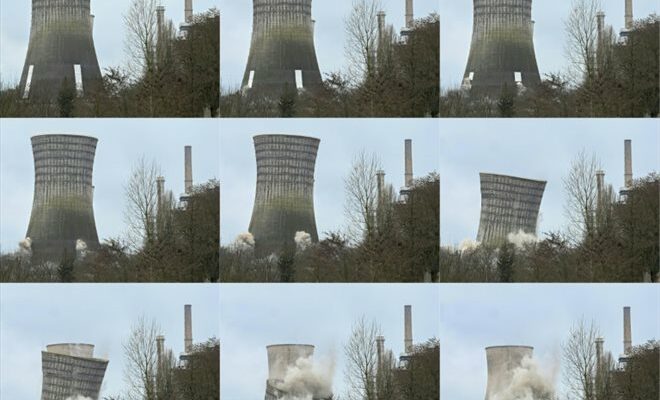The tallest tower of the Saint-Avold power station, in Moselle, during its blasting on February 11, 2024 (AFP/Jean-Christophe VERHAEGEN)
Some 10,000 tonnes of concrete destroyed in a matter of seconds: the highest tower of the Saint-Avold power station (Moselle) was “struck by lightning” on Sunday, as a symbol of the announced conversion of the site from coal to hydrogen.
Very close to the German border, the Emile Huchet power station, owned by GazelEnergie, dynamited cooling tower number 5 at 11:00 a.m., in a plume of gray smoke and under the watch of hundreds of captivated spectators.
“It’s a destruction which in fact is a rebirth, since we are destroying this air-cooling tower in order to be able to build instead a large hydrogen production project which will be the future of the site,” Jean told AFP. -Michel Mazalèrat, the president of GazelEnergie, the company that operates the plant.
Of the six air-cooling towers (cooling towers) on the site, only one will remain until the total conversion of the coal-fired power plant to biomass in 2027, as desired last September by President Emmanuel Macron.
Emile Huchet is one of only two coal-fired power stations still in operation in France, with that of Cordemais (Loire-Atlantique).
Both are preparing their conversion to biomass but the Saint-Avold site wants to become an “eco-platform”: it is planning other projects such as “Emil’hy” (for Emile Huchet and hydrogen), which should allow the by 2027, production of low-carbon and renewable hydrogen, by water electrolysis.
The engineering studies are being finalized and public consultation should begin at the end of February, Camille Jaffrelo, spokesperson for GazelEnergie, told AFP.
“A blast like this lasted 7 seconds, a hydrogen project takes 7 years,” she compared.
The project plans, for 2030, a total capacity of 400 MW and a production of 56,000 tonnes of hydrogen per year. Initially, the initial phase will primarily supply the German steelmaker Saarstahl Hoolding Saar (SHS), located opposite. To date, it represents an investment of 780 million euros.
– Pellets –

Series of images taken on February 11, 2024 during the blasting of the highest tower of the Saint-Avold power station, in Moselle, in the process of converting from coal to hydrogen (AFP/Jean-Christophe VERHAEGEN)
Originally intended to close permanently at the start of 2022, the site was called upon again in January 2023 to secure the country’s supply in a context of energy tension.
This year, the coal plant operated for two weeks in January, when it was cold, recalls Camille Jaffrelo. These days made it possible to move forward towards the conversion to biomass of the site, with a test of burning pellets, wood pellets.
A subsidiary of the EPH group of Czech businessman Daniel Kretinsky, GazelEnergie says it is “confident” after these tests and will propose a “road map” for this conversion.
Another project, called PARKES, for plastic recycling, must also be set up on the Carling-Saint-Avold platform. Its renewable energy will be supplied by GazelEnergie. The project leaders announced at the beginning of February a commissioning objective “by 2027”. It must induce 200 hires.
– Rehabilitation –
In Moselle Est, on the border with Germany, workers have suffered numerous site closures and are facing deindustrialization. “Here, we are rehabilitating wasteland,” says Camille Jaffrelo.
“There are no fears, no worries, it is an end announced, the end of a period”, reacts to AFP Salvatore Cascarella, president of the Saint-Avold urban community .
According to him, the East Moselle is starting to “become an Eldorado” with more than 2 billion euros of investments for new or already established companies. Ultimately, all projects in the sector must generate 2,500 jobs.
“The Saar government has released 2.6 billion euros to decarbonize their factories, they have the money, they want to move very quickly so we have to build very quickly,” he underlined.
The other French coal power plant, in Cordemais (Loire-Atlantique), was blocked at the beginning of February by the CGT, saying it doubted the future of its biomass conversion project.
EDF responded that the “progressive decarbonization” of Cordemais was indeed underway, with up to “20% biomass replacing coal”. The tests “went correctly”, according to the energy company.
© 2024 AFP
Did you like this article ? Share it with your friends using the buttons below.




